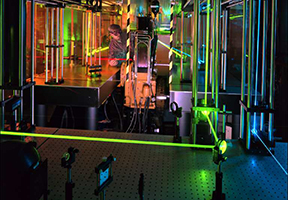
Last month Joe White, Detroit bureau chief and automotive editor for The Wall Street Journal, toured Sandia/California to learn about automotive-related happenings onsite. He wrote about his visit in his Oct. 22 Eyes on the Road column, headlined “Big Brains at Sandia National Lab Tackle the Future of Combustion.”
In that column, White had this to say about Sandia: “To a man and woman, the people at Sandia today are patriots dedicated to making America safer and stronger. Still, the challenge they’ve undertaken to help free personal mobility from petroleum isn’t so straightforward.”
While at Sandia, White met with Div. 8000 VP Paul Hommert; Terry Michalske, director of Biological and Energy Sciences Center 8300; Jay Keller, manager of Hydrogen and Combustion Technologies Dept. 8367; Bob Carling, director of Physical and Engineering Sciences Center 8700; and Dennis Siebers, manager of Engine Combustion Dept. 8362. He also participated in a video conference on biofuels and the Joint BioEnergy Initiative (JBEI) with Grant Heffelfinger (8330), senior manager of Molecular and Computational Biosciences.
White toured the Micro and Nano Technologies Laboratories, where he discussed storage research with Terry Johnson (8757) and the Metal Hydrides Center of Excellence with Lennie Klebanoff and Ewa Ronnebro (both 8755). Later in the day he visited Combustion Research Facility laboratories, with discussions on homogeneous charge compression ignition (HCCI) led by John Dec (8362); alternative fuels led by Chuck Mueller (8362); and the hydrogen internal combustion engine led by Sebastian Kaiser (8362) and Joseph Oefelein (8351).
“In Joe’s world, everyone is trying to sell a point of view, a product, or a technology. He clearly appreciated Sandia’s ability to provide an unbiased science and technology perspective,” says Mike Janes (8528), public relations officer for the California site. “I expect we’ll be seeing and hearing more from Joe in the future.”
White shared his expertise in a talk titled “Green Machines” that focused on the barriers to alternatives to gasoline and internal combustion engines. He noted that in the 20 years he’s spent covering the automotive industry, he’s seen the current trend toward energy-efficient cars come and go several times.
“Every time there has been a spike in energy prices, a conflict in the Middle East, or a surge in environmental sentiment in the popular culture, the automotive industry has responded by throwing open the doors of its R&D labs and showing the wonderful, super-efficient, advanced technology prototypes,” he said. “Then, when the heat goes off, the prototypes go back beyond the curtain and everything goes back to horsepower as usual.”
Right now, all three of the indicators White describes are happening. In his Oct. 22 column, he described this as “a trifecta — an energy-price spike, a Mideast war, and a surge of green consciousness symbolized now by Al Gore’s Nobel Peace Prize, which presumably will share space in his den with the Oscar for ‘An Inconvenient Truth.’”
He concluded that, in his opinion, right now there is a greater willingness to invest in new technology from the incremental to the revolutionary than at any other time in the modern era.
“Sooner or later the auto industry will face enormous pressure because of climate change and the price and scarcity of oil,” he said. “Twenty to 22 miles per gallon as an average is not going to cut it globally.”
The biggest hurdle, says White, is cost. “Old technology is cheap. Car makers will struggle to get over the cost hurdle of truly advanced fuel-saving technology. They will need a boost, either from higher fuel prices or gasoline taxes, or tax policies that make the up-front premiums irrelevant to consumers. None of the Big Three automakers has the capital to take an all-out risk on new technology — they can’t afford to sell vehicles that are too expensive or loaded with challenging, untested technology that is expensive to own and operate.”
But it’s a hurdle that researchers at Sandia are eager to attempt — and the brainpower and resources of Sandia and other national laboratories might just be what it takes. As White wrote in his column, “Maybe it makes sense to have a Manhattan Project to overcome the technical obstacles to wider use of clean fuel technology. Maybe it makes sense to redefine the problem.”
To read the full text of Joe White’s Oct. 22 column, go here. To watch the video stream of his “Green Machines” presentation, check this out.